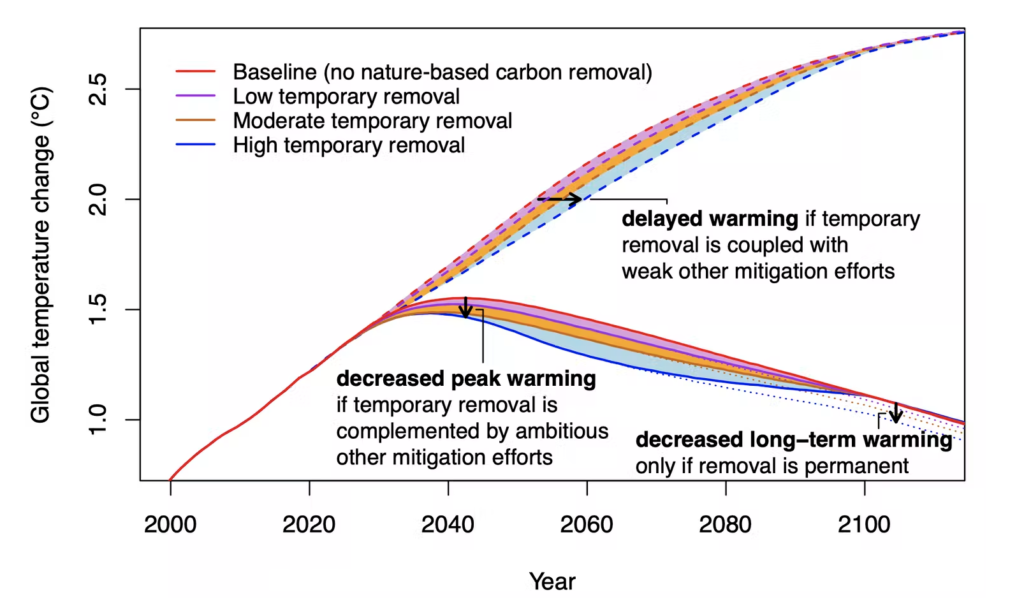The climate crisis is becoming an increasingly urgent issue, and if we want to save our planet, we need to act now. In recent years, policymakers have turned to tree planting as a solution to carbon emissions — but if we don’t stop burning fossil fuels, how effective will this solution really be?
To find out, a team of scientists from Concordia and Simon Fraser universities modelled the long-term outcomes of using trees to remove carbon dioxide from the atmosphere. Their findings show that while planting trees can help, we need to eliminate fossil fuel emissions if we want the solution to be permanent.
The study was published in Nature Communications Earth & Environment.
Trees can trap excess carbon emissions
When we burn fossil fuels — to generate electricity or power our cars, for example — we release carbon dioxide and other greenhouse gases into the atmosphere. These gases get trapped in the atmosphere over time, leading our planet to heat up.
Many scientists have pointed to tree planting as a potential solution to this problem. Trees not only absorb and then sequester carbon dioxide, but can also enhance biodiversity and support human well-being.
But can trees really eliminate our greenhouse gas problem permanently — especially if we don’t change our other habits? Human activities that disturb forests — such as old growth logging, for example — will actually cause this sequestered carbon to be released back into the atmosphere. Wildfires also release carbon, and have become more frequent in recent years.
Given all this, tree planting may not be enough in the long term.
To investigate just how much tree planting alone really will do for our planet, the team behind the study modelled the Earth’s climate over the upcoming 100 years. The effects of new carbon dioxide emissions will persist for many centuries; trees, on the other hand, will only store this excess carbon for as long as they remain undisturbed.
The authors modelled various scenarios: those where we remain the same, those where we continue to emit carbon dioxide at the same rate but plant varying levels of trees, and those where we reduce our carbon emissions while also planting trees. In all scenarios, they assumed that carbon stored in newly planted trees would eventually return to the atmosphere.
Trees can help, but eliminating emissions still necessary
Unfortunately, their models showed that while trees can temporarily delay global warming, they cannot stop our planet’s temperature from increasing forever. Even in the scenario with the highest number of trees planted, we will only be able to delay a 2 degree Celsius increase in global temperatures by eight years.
While these results may seem bleak, there’s still hope. If tree planting is coupled with reduced emissions that eventually decrease to net-zero, the authors found that global temperatures will begin to decline in the latter half of the century. And if we plant more trees, we can prevent the temperature from getting too high before this decline begins.

“[I]f future emissions are decreased rapidly to net-zero by mid-century […] temporary nature-based carbon removal would decrease the temperature peak by as much as a tenth of a degree,” the authors explained in an article for The Conversation Canada.
“This might seem small, but it is an important and tangible climate benefit that will only occur if the world also succeeds in eliminating fossil fuel carbon dioxide emissions over the coming decades.”
The authors urge policymakers to consider strategies for reducing our emissions alongside tree-planting initiatives. While Canada’s commitment to planting two billion trees over the next few decades will help — and will come with many additional benefits for the environment — we need to hold our government accountable for also reducing emissions to net-zero by the middle of the century.
“It is critical that nature-based climate solution are not presented as an alternative to other climate mitigation options,” the authors conclude.
“As a complementary action however, they could play an important role in meeting both climate and other sustainability goals.”








































